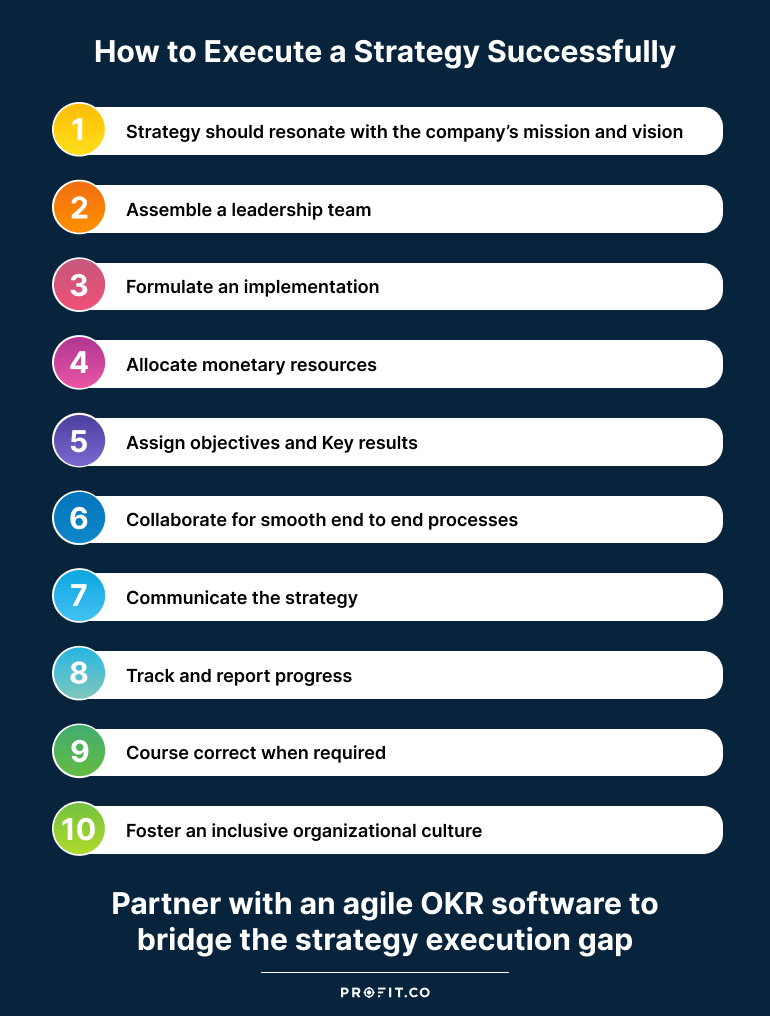What is Strategy Execution?
As the name suggests, strategy execution is the successful execution of strategy. Translating an organization’s strategic initiatives into action after a lengthy planning process for the best business results is why strategy execution is so important.
Why is Strategy Execution important?
Organizations spend big money on strategic initiatives, but there often is a gap between strategy planning and execution. As a result, customers will not have access to new technology or service if a company fails to execute a marketing or selling strategy.
At the end of the day, no matter how good the strategy, if it doesn’t see the light of day, it’s as good as not having a strategy at all in the first place.
A lot of times, strategies fail not because they are not good, but because they are not correctly executed, they are not aligned to the day-to-day objectives of employees. Not only does it not yield the desired business results, but it also ends up being a waste of effort, resources, and time. Every employee irrespective of their position has an important role to play in the success of an organization, and their efforts need to be aligned with the overall goal of the company. This is why Strategy Execution is essential. So that everything is aligned, falls into place, and bridges the gap between strategy and execution.

How to Execute a Strategy Successfully?
When it’s time to execute a strategy, it may or may not go according to plan, depending on the market. It’s not always easy to predict how the market will react to different situations, but we can stay prepared with backup strategies.
Mentioned below are some ways in which companies can successfully execute a strategy:
- Ensure that the plans are in alignment with the company’s mission and vision
- Put together a leadership team
- Have an implementation plan in place
- Allocate monetary resources around strategy execution
- Assign objectives and responsibilities
- Ensure collaboration between structures for smooth end-to-end processes
- Align people
- Communicate the strategy
- Track and report progress
- Course correct if required
- Foster an organizational culture that supports the strategy
1. Ensure that the plans are in alignment with the company’s mission and vision
Ensure that the plans align with the company’s mission and vision, for if they aren’t the strategy will surely fail. It doesn’t matter if the strategic alignment is established from the top-down, or bottom-up. The important thing is there has to be strategic alignment. OKR Alignment helps to visualize each and every employee’s contribution towards the organization’s goals which in turn helps to manage the dependencies in an efficient way.
2. Put together a leadership team
Put together a leadership team that will work toward steering the company to its end goal. Set the outcome for the team and guide the team into delivering that outcome. Once we know the goals, pick the best people to deliver results.
3. Have an implementation plan in place
Have an implementation plan in place. Implementation should be mindful of the team’s people and their strengths and set realistic goals. Make sure to have frequent meetings to determine whether the implementation plan is progressing according to plan or if there is a need to correct the course.
4. Allocate monetary resources around strategy execution
It’s essential to allocate a budget for strategy execution. Do not go overboard, but don’t be too frugal in allocating monetary resources. Trying to cut costs to save up might end up in you spending too much, making up for the mistake of not budgeting right in the first place. So make an informed decision while allocating monetary resources.
5. Assign objectives and responsibilities
When executing a strategy, don’t assume anything. Make it very clear what the objectives and responsibilities are and what is expected of each team or individual. Leave no grey areas when executing a strategy.
6. Ensure collaboration between structures for a smooth end to end processes
When people work in silos, they don’t interact with each other. This results in little or no interaction between teams, which can be hugely detrimental to the organization and its customers.
Make sure that teams and departments do not work in silos, but collaborate, and communicate with each other to align end-to-end processes.
7. Align people
Every employee needs to know the common benefit that they are working toward. Aligning everyone’s tasks and goals in the organization to the company’s goals helps build a strong foundation.
8. Communicate the strategy
Yet another reason why communication is key. For a strategy to be executed successfully, it needs to be communicated well. To help communicate strategy and maintain transparency throughout the entire quarter, you can use an agile and intuitive OKR management software such as Profit.co. You can start using Profit.co completely free today and achieve more, more efficiently.
9. Track and report progress
To know how well a project is progressing, it’s important to monitor it periodically; set weekly or biweekly meetings with the team to track progress and make reports. Organizations can make this tracking process more streamlined by using task management software that allows the teams to be aligned. Regularly meeting with employees allows you to review goal progression. This is when you provide feedback on how they’re performing and determine if they’re on track to complete their goals. This transparency allows team members to grow. Plus, having leaders who care about their progress makes employees feel like important contributors to the company, fostering better engagement and productivity.
10. Course correct if required
There are so many things at play when a strategy is set into motion. Even if everything internally with the team is going well, there can be a lot of outside factors that might throw things out of control. Don’t be afraid to course correct if required. This is where periodic reviews come in handy – it gives the team insight into if any adjustments need to be made.
11. Foster an organizational culture that supports the strategy
A strong organization has a strong organizational culture. It is the backbone of every department and process. It defines the personality of the organization and sets the tone for how to execute the strategies. With a great company culture, it’s easier to attract and retain top talent. Your existing employees become brand ambassadors, which benefits your business. Take your business to the next level by nurturing culture and encouraging all team members to achieve their full potential.
Goals are pure fantasy unless you have a specific plan to achieve them.
3 secrets for effective and successful strategy execution?
To increase the chances of the strategy execution being more successful, the following areas can be addressed:
1. Set clear corporate priorities
2. Strategic goals and objectives need clear owners to ensure success
3. Establishing a learning organization
1. Set clear corporate priorities
An organization can have numerous strategic objectives, but not all are equally important. It is important for an organization to know which objectives are more important and to prioritize those. When an organization has its strategic decisions aligned, all teams will focus on what’s important. When they aren’t aligned, different teams will be working on different priorities working in opposition to each other. It’s important to bear in mind that these strategic priorities change over time. What’s important now might not be important a few months down the line. Therefore, be sure to keep track of how things change and when to re-prioritize.
2. Strategic goals and objectives need clear owners to ensure success
Assign owners to strategic goals and objectives. For when people know what they are accountable for, they will be a more productive and higher likelihood of them achieving those goals. Objectives and key results (OKRs) are a powerful framework used in the modern workplace because it takes goal-setting to a new level, but are still a simple way to set, track, and measure goals without being overly complicated. OKRs and aligning people to your strategy are necessary for proper execution. The OKR framework helps the business define, plan, and execute its strategy. From the bottom up, everyone in the organization has a clear picture of the business objectives and achieves those results.
3. Establishing a learning organization
Nothing is permanent. Markets change, products change to meet market needs, product development happens, new competitors enter the market, existing competitors leave, the plans that you made earlier become obsolete – so many changes take place. The greatest strength of the OKR goal-setting framework is the ability to consolidate these learnings and feedback from weekly reviews, make an action plan based on them, and implement changes quickly to achieve better performance and results immediately.
In addition to short-term reviews, you can also conduct an in-depth review at the end of the review period. In this review, the performance can be scored and graded, and the percentage of achievement towards the overall achievements can be tracked. And through it all, it’s important that the organization learns something from it so that it can grow and adapt to the changes that are thrown at it.
In Conclusion
Goal-setting, objectives, key results, strategy; all these words fly around the business world today and are probably mentioned in every business meeting. Having an OKR process to bridge the strategy execution gap is more than just a theory. Luckily, many businesses use the OKR framework to effectively run their business today. To make strategy execution a success, several elements need to come together. The organization needs to adopt a holistic approach to successfully execute a strategy.
Also, make sure you have the right software to help you reach your full potential– to learn how Profit.co can help you focus on your most important goals and measure your progress, book a free demo with our experts today!

